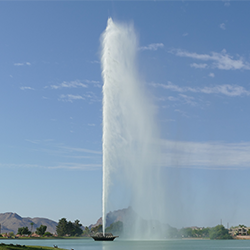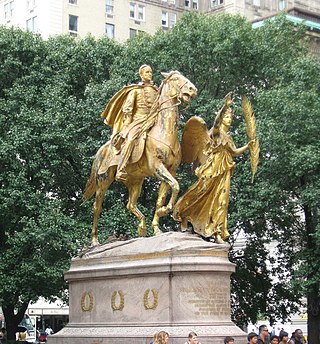
A fountain pen is a writing instrument that uses a metal nib to apply water-based ink, or special pigment ink -suitable for fountain pens- to paper. It is distinguished from earlier dip pens by using an internal reservoir to hold ink, eliminating the need to repeatedly dip the pen in an inkwell during use. The pen draws ink from the reservoir through a feed to the nib and deposits the ink on paper via a combination of gravity and capillary action. Filling the reservoir with ink may be achieved manually, via the use of an eyedropper or syringe, or via an internal filling mechanism that creates suction or a vacuum to transfer ink directly through the nib into the reservoir. Some pens employ removable reservoirs in the form of pre-filled ink cartridges.

Fountains Abbey is one of the largest and best preserved ruined Cistercian monasteries in England. It is located approximately 3 miles (5 km) south-west of Ripon in North Yorkshire, near to the village of Aldfield. Founded in 1132, the abbey operated for 407 years, becoming one of the wealthiest monasteries in England until its dissolution, by order of Henry VIII, in 1539.

A pen is a common writing instrument that applies ink to a surface, usually paper, for writing or drawing. Early pens such as reed pens, quill pens, dip pens and ruling pens held a small amount of ink on a nib or in a small void or cavity that had to be periodically recharged by dipping the tip of the pen into an inkwell. Today, such pens find only a small number of specialized uses, such as in illustration and calligraphy. Reed pens, quill pens and dip pens, which were used for writing, have been replaced by ballpoint pens, rollerball pens, fountain pens and felt or ceramic tip pens. Ruling pens, which were used for technical drawing and cartography, have been replaced by technical pens such as the Rapidograph. All of these modern pens contain internal ink reservoirs, such that they do not need to be dipped in ink while writing.

Fountain Hills is a town in Maricopa County, Arizona, United States. Known for its impressive fountain, once the tallest in the world, it borders the Fort McDowell Yavapai Nation, Salt River Pima-Maricopa Indian Community, and Scottsdale. The population was 23,820 as of the 2020 census. Between the 1990 and 2000 censuses it was the eighth-fastest-growing place among cities and towns in Arizona. The median value of an owner-occupied housing during the period 2016-2020 was estimated at $402,100.

The City of Fountain is a home rule municipality located in El Paso County, Colorado, United States. The city population was 29,802 at the 2020 United States Census, a +15.31% increase since the 2010 United States Census. Fountain is a part of the Colorado Springs, CO Metropolitan Statistical Area and the Front Range Urban Corridor.

The Fountain of Youth is a mythical spring which allegedly restores the youth of anyone who drinks or bathes in its waters. Tales of such a fountain have been recounted around the world for thousands of years, appearing in the writings of Herodotus, in the Alexander romance, and in the stories of Prester John. Stories of similar waters also featured prominently among the people of the Caribbean during the Age of Exploration ; they spoke of the restorative powers of the water in the mythical land of Bimini. Based on these many legends, explorers and adventurers looked for the elusive Fountain of Youth or some other remedy to aging, generally associated with magic waters. These waters might have been a river, a spring or any other water-source said to reverse the aging process and to cure sickness when swallowed or bathed in.

Fountains of Wayne was an American rock band that formed in New York City in 1995. The band included founding members Chris Collingwood, Adam Schlesinger, Jody Porter, and Brian Young. They released six albums from 1996 to 2011 before effectively disbanding in 2013. They are best known for the Grammy-nominated song "Stacy's Mom".

The Trevi Fountain is an 18th-century fountain in the Trevi district in Rome, Italy, designed by Italian architect Nicola Salvi and completed by Giuseppe Pannini in 1762 and several others. Standing 26.3 metres (86 ft) high and 49.15 metres (161.3 ft) wide, it is the largest Baroque fountain in the city and one of the most famous fountains in the world.

A fountain, from the Latin "fons", meaning source or spring, is a decorative reservoir used for discharging water. It is also a structure that jets water into the air for a decorative or dramatic effect.

The Villa d'Este is a 16th-century villa in Tivoli, near Rome, famous for its terraced hillside Italian Renaissance garden and especially for its profusion of fountains. It is now an Italian state museum, and is listed as a UNESCO World Heritage Site.

Fontana del Tritone is a seventeenth-century fountain in Rome, by the Baroque sculptor Gian Lorenzo Bernini. Commissioned by his patron, Pope Urban VIII, the fountain is located in the Piazza Barberini, near the entrance to the Palazzo Barberini that Bernini helped to design and construct for the Barberini, Urban's family. This fountain should be distinguished from the nearby Fontana dei Tritoni by Carlo Francesco Bizzaccheri in Piazza Bocca della Verità which features two Tritons.

The Diana, Princess of Wales Memorial Fountain is a memorial in London dedicated to Diana, Princess of Wales, who died in a car crash in 1997. It was designed to express Diana's spirit and love of children.

A drinking fountain, also called a water fountain or water bubbler, is a fountain designed to provide drinking water. It consists of a basin with either continuously running water or a tap. The drinker bends down to the stream of water and swallows water directly from the stream. Modern indoor drinking fountains may incorporate filters to remove impurities from the water and chillers to lower its temperature. Drinking fountains are usually found in public places, like schools, rest areas, libraries, and grocery stores.

Fountain is a readymade sculpture by Marcel Duchamp in 1917, consisting of a porcelain urinal signed "R. Mutt". In April 1917, an ordinary piece of plumbing chosen by Duchamp was submitted for an exhibition of the Society of Independent Artists, the inaugural exhibition by the Society to be staged at the Grand Central Palace in New York. When explaining the purpose of his readymade sculpture, Duchamp stated they are "everyday objects raised to the dignity of a work of art by the artist's act of choice." In Duchamp's presentation, the urinal's orientation was altered from its usual positioning. Fountain was not rejected by the committee, since Society rules stated that all works would be accepted from artists who paid the fee, but the work was never placed in the show area. Following that removal, Fountain was photographed at Alfred Stieglitz's studio, and the photo published in the Dada journal The Blind Man. The original has been lost.

The Fountain is a 2006 American epic romantic drama film written and directed by Darren Aronofsky and starring Hugh Jackman and Rachel Weisz. Blending elements of fantasy, history, spirituality and science fiction, the film consists of three storylines involving immortality and the resulting loves lost, and one man's pursuit of avoiding this fate in this life or beyond it. Jackman and Weisz play sets of characters bonded by love across time and space: a conquistador and his ill-fated queen, a modern-day scientist and his cancer-stricken wife, and a traveler immersed in a universal journey alongside aspects of his lost love. The storylines—interwoven with use of match cuts and recurring visual motifs—reflect the themes and interplay of love and mortality.

Fontana dei Quattro Fiumi is a fountain in the Piazza Navona in Rome, Italy. It was designed in 1651 by Gian Lorenzo Bernini for Pope Innocent X whose family palace, the Palazzo Pamphili, faced onto the piazza as did the church of Sant'Agnese in Agone of which Innocent was the sponsor.

The Metropolitan Drinking Fountain and Cattle Trough Association is an association that was set up in London by Samuel Gurney, a member of Parliament and philanthropist, and Edward Thomas Wakefield, a barrister, in 1859 to provide free drinking water.

The Fontana della Barcaccia is a Baroque-style fountain found at the foot of the Spanish Steps in Rome's Piazza di Spagna. Pope Urban VIII commissioned Pietro Bernini in 1623 to build the fountain as part of a prior Papal project to erect a fountain in every major piazza in Rome. The fountain was completed between 1627 and 1629 by Pietro possibly along with the help of his son Gian Lorenzo Bernini, especially after his father's death on August 29, 1629.

Fontana delle Api is a fountain located in the Piazza Barberini in Rome where the Via Veneto enters the piazza. It was sculpted by Gian Lorenzo Bernini and completed in April 1644.

Grand Army Plaza is a square at the southeast corner of Central Park in Manhattan, New York City, at the intersection of Fifth Avenue and Central Park South, covering two blocks on the west side of Fifth Avenue between 58th and 60th Streets. It contains an equestrian statue of William Tecumseh Sherman on its northern half and the Pulitzer Fountain on its southern half.























